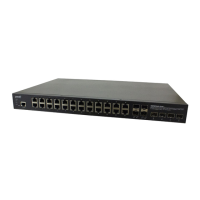Lantronix SISPM1040-xxxx-L3 Web User Guide
33856 Rev. A https://www.lantronix.com/ 478
Appendix B - MRP Pre-Requisites and Application Examples
You can configure Media Redundancy Protocol (MRP) parameters via the Web UI at Configuration > MRP and monitor them
at Monitor > MRP, or via the CLI. See the CLI Reference for Command Line operation.
According to ANSI, IEC 62439-2 Ed. 1.0 b:2010 is applicable to high-availability automation networks based on ISO/IEC 8802-
3 / IEEE 802.3 Ethernet technology. It specifies a recovery protocol based on a ring topology, designed to react
deterministically on a single failure of an inter-switch link or switch in the network, under the control of a dedicated Media
Redundancy Manager (MRM) node.
Media Redundancy Protocol per IEC 62439-2 is an interoperable ring technology designed to allow a switch to connect onto
a universal redundant high speed ring. MRP is self-healing and self-adjusting, requiring no operator interaction. MRP is
based on the concept of standby connections for seamless redundancy.
MRP Description
1. MRP operates at the MAC Layer of the Ethernet Switch.
2. The Ring Manager is called the Media Redundancy Manager (MRM).
3. Ring Clients are called Media Redundancy Clients (MRCs).
4. MRM and MRC ports support three Status Types:
a. Disabled ring ports drop all the received frames.
b. Blocked ring ports drop all the received frames except the MRP control frames.
c. Forwarding ring ports forward all the received frames.
5. Ring Reconfiguration speed is 200 ms for 50 switches on average.
6. The MRM continuously sends Watchdog Packets into the ring network to verify communication between ring points.
7. During normal operation, no packets are transmitted over the redundant link.
8. When the MRM no longer receives the Watchdog Packets it sent out, the redundant path is immediately activated, and
it becomes the primary layer 2 packet path.
9. When the failed link is restored:
a. The MRM switches back to normal operation and the first Path becomes the primary path again.
b. You can configure a period of time before the MRM switches back to the primary path (to prevent the circuit from
flapping if it is not stable).
MRP Operation
Normal operation: the network works in the Ring-Closed status. In this status, one of the MRM ring ports is blocked, while
the other is forwarding. Conversely, both ring ports of all MRCs are forwarding. Loops are avoided because the physical ring
topology is reduced to a logical stub topology.
Failure mode: the network works in the Ring-Open status. For instance, in case of failure of a link connecting two MRCs,
both ring ports of the MRM are forwarding. The MRCs adjacent to the failure have a blocked and a forwarding ring port; the
other MRCs have both ring ports forwarding. The physical ring topology is also a logical stub topology in the Ring-Open
status.

